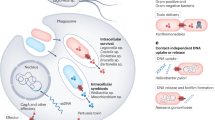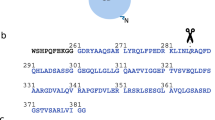Abstract
Pseudomonas aeruginosa produces a large number of exoproteins, ranging from the ADP-ribosyltransferases exotoxin A and ExoS to degradative enzymes, such as elastase and chitinase. As it is a gram-negative bacterium, P. aeruginosa must be able to transport these exoproteins across both membranes of the cell envelope. In addition, also proteins that are part of cellular appendages, such as type IV pili and flagella, have to cross the cell envelope. Whereas the majority of the proteins transported across the inner membrane are dependent on the Sec channel, the systems for translocation across the outer membrane seem to be more diverse. Gram-negative bacteria have invented a number of different strategies during the course of evolution to achieve this goal. Although these transport machineries seem to be radically different, many of them actually depend on a member of the secretin protein family for their function. Recent results show that secretins form a large complex in the outer membrane, which constitutes the actual translocation channel. Understanding the working mechanism of this protein translocation channel could open up new strategies to target molecular machineries at the heart of many important virulence factors.

Similar content being viewed by others
References
Andersen C, Hughes C, Koronakis V (2000) Chunnel vision. Export and efflux through bacterial channel-tunnels. EMBO Rep 1:313–318
Ast VM, Schoenhofen IC, Langen GR, Stratilo CW, Chamberlain MD, Howard SP (2002) Expression of the ExeAB complex of Aeromonas hydrophila is required for the localization and assembly of the ExeD secretion port multimer. Mol Microbiol 44:217–231
Ball G, Durand E, Lazdunski A, Filloux A (2002) A novel type II secretion system in Pseudomonas aeruginosa. Mol Microbiol 43:475–485
Bitter W, Koster M, Latijnhouwers M, de Cock H, Tommassen, J (1998) Formation of oligomeric rings by XcpQ and PilQ, which are involved in protein transport across the outer membrane of Pseudomonas aeruginosa. Mol Microbiol 27:209–219
Bouley J, Condemine G, Shevchik VE (2001) The PDZ domain of OutC and the N-terminal region of OutD determine the secretion specificity of the type II out pathway of Erwinia chrysanthemi. J Mol Biol 308:205–219
Braun P, de Groot A, Bitter W, Tommassen, J (1998) Secretion of elastinolytic enzymes and their propeptides by Pseudomonas aeruginosa. J Bacteriol 180:3467–3469
Brok R, Van Gelder P, Winterhalter M, Ziese U, Koster AJ, de Cock H, Koster M, Tommassen J, Bitter W (1999) The C-terminal domain of the Pseudomonas secretin XcpQ forms oligomeric rings with pore activity. J Mol Biol 294:1169–1179
Christie PJ (2001) Type IV secretion: intercellular transfer of macromolecules by systems ancestrally related to conjugation machines. Mol Microbiol 40:294–305
Collins RF, Davidsen L, Derrick JP, Ford RC, Tonjum T (2001) Analysis of the PilQ secretin from Neisseria meningitidis by transmission electron microscopy reveals a dodecameric quaternary structure. J Bacteriol 183:3825–3832
Condemine G, Shevchik VE (2000) Overproduction of the secretin OutD suppresses the secretion defect of an Erwinia chrysanthemi outB mutant. Microbiology 146:639–647
Cornelis GR, Van Gijsegem F (2000) Assembly and function of type III secretory systems. Annu Rev Microbiol 54:735–774.
Crago AM, Koronakis V (1998) Salmonella InvG forms a ring-like multimer that requires the InvH lipoprotein for outer membrane localization. Mol Microbiol 30:47–56
Daefler S, Russel M (1998) The Salmonella typhimurium InvH protein is an outer membrane lipoprotein required for the proper localization of InvG. Mol Microbiol 28:1367–1380
Daefler S, Russel M, Model P (1997a) Module swaps between related translocator proteins pIV(f1), pIV(IKe) and PulD: identification of a specificity domain. J Mol Biol 266:978–992
Daefler S, Guilvout I, Hardie KR, Pugsley AP, Russel M (1997b) The C-terminal domain of the secretin PulD contains the binding site for its cognate chaperone, PulS, and confers PulS dependence on pIVf1 function. Mol Microbiol 24:465–475
Drake SL, Sandstedt SA, Koomey M (1997) PilP, a pilus biogenesis lipoprotein in Neisseria gonorrhoeae, affects expression of PilQ as a high-molecular-mass multimer. Mol Microbiol 23:657–668
Dubnau D (1999) DNA uptake in bacteria. Annu Rev Microbiol 53:217–244
Duong F, Bonnet E, Geli V, Lazdunski A, Murgier M, Filloux A (2001) The AprX protein of Pseudomonas aeruginosa: a new substrate for the Apr type I secretion system. Gene 262:147–153
Filloux A, Michel G, Bally M (1998) GSP-dependent secretion in Gram-negative bacteria: the Xcp system of Pseudomonas aeruginosa. FEMS Microbiol Rev 22:177–198
Folders J, Tommassen J, van Loon LC, Bitter W (2000) Identification of a chitin-binding protein secreted by Pseudomonas aeruginosa. J Bacteriol 182:1257–1263
Folders J, Algra J, Roelofs MS, van Loon LC, Tommassen J, Bitter W (2001) Characterization of Pseudomonas aeruginosa chitinase, a gradually secreted protein. J Bacteriol 183:7044–7052
Genin B, Boucher CA (1994) A superfamily of proteins involved in different secretion pathways in gram-negative bacteria: modular structure and specificity of the N-terminal domain. Mol Gen Genet 243:112–118
Hahn HP (1997) The type-4 pilus is the major virulence-associated adhesin of Pseudomonas aeruginosa. Gene 192:99–108
Hancock RE (1997) The bacterial outer membrane as a drug barrier. Trends Microbiol 5:37–42
Hardie KR, Lory S, Pugsley AP (1996) Insertion of an outer membrane protein in Escherichia coli requires a chaperone-like protein. EMBO J 15:978–988
Henderson IR, Navarro-Garcia F, Nataro JP (1998) The great escape: structure and function of the autotransporter proteins. Trends Microbiol 6:370–378
Jacob-Dubuisson F, Locht C, Antoine R (2001) Two-partner secretion in gram-negative bacteria: a thrifty, specific pathway for large virulence proteins. Mol Microbiol 40:306–313
Kazmierczak BI, Mielke DL, Russel M, Model P (1994) pIV, a filamentous phage protein that mediates phage export across the bacterial cell envelope, forms a multimer. J Mol Biol 238:187–198
Koster M, Bitter W, de Cock H, Allaoui A, Cornelis GR, Tommassen J (1997) The outer membrane component, YscC, of the Yop secretion machinery of Yersinia enterocolitica forms a ring-shaped multimeric complex. Mol Microbiol 26:789–797
Kubori T, Matsushima Y, Nakamura D, Uralil J, Lara-Tejero M, Sukhan A, Galan JE, Aizawa SI (1998) Supramolecular structure of the Salmonella typhimurium type III protein secretion system. Science 280:602–605
Létoffé S, Redeker V, Wandersman C (1998) Isolation and characterization of an extracellular haem-binding protein from Pseudomonas aeruginosa that shares function and sequence similarities with the Serratia marcescens HasA haemophore. Mol Microbiol 28:1223–1234
Linderoth NA, Simon MN, Russel M (1997) The filamentous phage pIV multimer visualized by scanning transmission electron microscopy. Science 278:1635–1638
MacRae TH, Dobson WJ, McCurdy HD (1977) Fimbriation in gliding bacteria. Can J Microbiol 23:1096–1108
Marciano DK, Russel M, Simon SM (1999) An aqueous channel for filamentous phage export. Science 284:1516–1519
Martin PR, Hobbs M, Free PD, Jeske Y, Mattick JS (1993) Characterization of pilQ, a new gene required for the biogenesis of type 4 fimbriae in Pseudomonas aeruginosa. Mol Microbiol 9:857–868
Martinez A, Ostrovsky P, Nunn DN (1998) Identification of an additional member of the secretin superfamily of proteins in Pseudomonas aeruginosa that is able to function in type II protein secretion. Mol Microbiol 28:1235–1246
Mattick JS, Whitchurch CB, Alm RA (1996) The molecular genetics of type-4 fimbriae in Pseudomonas aeruginosa. Gene 179:147–155
Michel G, Ball G, Goldberg JB, Lazdunski A (2000) Alteration of the lipopolysaccharide structure affects the functioning of the Xcp secretory system in Pseudomonas aeruginosa. J Bacteriol 182:696–703
Newhall WJ, Wilde CE, Sawyer WD, Haak RA (1980) High-molecular-weight antigenic protein complex in the outer membrane of Neisseria gonorrhoeae. Infect Immun 27:475–482
Nouwen N, Ranson N, Saibil H, Wolpensinger B, Engel A, Ghazi A, Pugsley AP (1999) Secretin PulD: association with pilot PulS, structure, and ion-conducting channel formation. Proc Natl Acad Sci USA 96:8173–8177
Nouwen N, Stahlberg H, Pugsley AP, Engel A (2000) Domain structure of secretin PulD revealed by limited proteolysis and electron microscopy. EMBO J 19:2229–2236
Okino N, Ichinose S, Omori A, Imayama S, Nakamura T, Ito M (1999) Molecular cloning, sequencing, and expression of the gene encoding alkaline ceramidase from Pseudomonas aeruginosa. J Biol Chem 274:36616–36622
Opalka N, Beckmann R, Boisset N, Simon MN, Russel M, Darst SA (2003) Structure of the filamentous phage pIV multimer by cryo-electron microscopy. J Mol Biol 325:461–470
Ostroff RM, Vasil AI, Vasil ML (1990) Molecular comparison of a non-hemolytic and a hemolytic phospholipase C from Pseudomonas aeruginosa. J Bacteriol 172:5915–5923
Sandkvist M (2001a) Type II secretion and pathogenesis. Infect Immun 69:3523–3535
Sandkvist M (2001b) Biology of type II secretion. Mol Microbiol 40:271–283
Schmidt SA, Bieber D, Ramer SW, Hwang J, Wu CY, Schoolnik G (2001) Structure-function analysis of BfpB, a secretin-like protein encoded by the bundle-forming-pilus operon of enteropathogenic Escherichia coli. J Bacteriol 183:4848–4859
Schulz GE (2000) β-Barrel membrane proteins. Curr Opin Struct Biol 10:443–447
Scott ME, Dossani ZY, Sandkvist M (2001) Directed polar secretion of protease from single cells of Vibrio cholerae via the type II secretion pathway. Proc Natl Acad Sci USA 98:13978–13983
Shevchik VE, Condemine G (1998) Functional characterization of the Erwinia chrysanthemi OutS protein, an element of a type II secretion system. Microbiology 144:3219–3228
Skerker JM, Shapiro L (2000) Identification and cell cycle control of a novel pilus system in Caulobacter crescentus. EMBO J 19:3223–3234
Stover CK, Pham XQ, Erwin AL, Mizoguchi SD, Warrener P, Hickey MJ, Brinkman FS, Hufnagle WO, Kowalik DJ, Lagrou M, Garber RL, Goltry L, Tolentino E, Westbrock-Wadman S, Yuan Y, Brody LL, Coulter SN, Folger KR, Kas A, Larbig K, Lim R, Smith K, Spencer D, Wong GK, Wu Z, Paulsen IT (2000) Complete genome sequence of Pseudomonas aeruginosa PA01, an opportunistic pathogen. Nature 406:959–964
Wall D, Kolenbrander PE, Kaiser D (1999) The Myxococcus xanthus pilQ (sglA) gene encodes a secretin homolog required for type IV pilus biogenesis, social motility, and development. J Bacteriol 181:24–33
Wilderman PJ, Vasil AI, Johnson Z, Wilson MJ, Cunliffe HE, Lamont IL, Vasil ML (2001) Characterization of an endoprotease (PrpL) encoded by a PvdS-regulated gene in Pseudomonas aeruginosa. Infect Immun 69:5385–5394
Wolfgang M, van Putten JP, Hayes SF, Dorward D, Koomey M (2000) Components and dynamics of fiber formation define a ubiquitous biogenesis pathway for bacterial pili. EMBO J 19:6408–6418
Yahr TL, Goranson J, Frank DW (1996) Exoenzyme S of Pseudomonas aeruginosa is secreted by a type III pathway. Mol Microbiol 22:991–1003
Acknowledgements
I thank Christina Vandenbroucke-Grauls for critically reading the manuscript and Hans de Cock for help with electron microscopic analysis of XcpQ.
Author information
Authors and Affiliations
Corresponding author
Rights and permissions
About this article
Cite this article
Bitter, W. Secretins of Pseudomonas aeruginosa: large holes in the outer membrane. Arch Microbiol 179, 307–314 (2003). https://doi.org/10.1007/s00203-003-0541-8
Received:
Revised:
Accepted:
Published:
Issue Date:
DOI: https://doi.org/10.1007/s00203-003-0541-8




